Avoid These 12 Email Marketing Mistakes That Are Hurting Your Business
Email marketing campaigns are important in today’s business marketing. They are a great way of gaining new customers and promoting your products and services. Yet, if executed poorly, you run the risk of wasting time, energy and losing money and sales. Your email marketing isn’t just about gaining subscribers, it’s also about converting them into customers.

If you are having trouble attracting new subscribers, retaining subscribers, and/or converting subscribers, there is a high probability you are going wrong somewhere with your campaign. While it’s ok to make mistakes, it’s also important to learn from them and try not to make them in the future. Here are 12 mistakes that you need to avoid making altogether.
1. Stop forgetting about your new subscribers
It happened, finally. You landed a new subscriber, but now what do you do? If you answered wait a few days and then hit them with an email outlining your great product, you are doing it wrong. This is a huge mistake. The first email you need to send is a welcome email. The first email you send tends to be the most read email. Why? This is when your readers are most engaged with you and your brand. They just signed up for your email marketing. You are fresh, new, and exciting in their minds.
There is no right or wrong way to write a welcoming email really. Some can be humorous, while others no-nonsense and straight down to business. The thing that matters is that it represents you All welcoming emails should have the following:
- Welcome the reader
- Introduce yourself or the business
- A good lead into what will follow
If you want to keep your subscribers’ attention then leading with a great welcoming email is essential and since it sets the tone for all of your other emails, it paves the way for future sales.
2. A mismatch between your campaign and reader expectations
Your subscribers are there because your brand and company intrigue them, and you are offering them something they need or desperately want. So, if your email content doesn’t back up their expectation, they are going to click unsubscribe pretty quickly.
“The content you send out to your email list needs to be well thought out, of high quality, and consistent with your company branding. You will lose money and subscribers if your email marketing doesn’t live up to your reader’s expectations.” explains Ray Schmid, a tech blogger at Paperfellows and Coursework Writing. If you lose a subscriber, the best email copy won’t matter because they won’t be reading it at all.
How do you fail at meeting expectations? There are two key things that cause a mismatch:
- Not sticking to your promised schedule-if you said a weekly email, then deliver on it.
- Not sticking to your chosen topic: If you promised to blog tips but are sending emails on weight loss tips, then they are going to bail on you pretty quick.
Keeping these two points in mind when you are crafting your email content will help you avoid creating a customer mismatch.
3. You Forgot to include the Call to Action
The CTA is a crucial part of your email campaign and forgetting can cost you money. Whether the content is a blog post or landing page or an email, a call to action needs to be included. The Call to Action encourages your subscribers to engage with your content. Your audience is likely highly intelligent, however, without a call to action, they might overlook what you want them to do with your content. You have to give them some guidance in the right direction and a CTA is a way to do this.
Before you write the first word of your email, have a clear vision in mind of what you want your reader to do. Are you promoting your content? Selling a new product? Providing a service? Then focus on the email contents, leading them to the outcome you want for them.
Then, make the call to action easily recognisable and relevant to what you want your outcome to be. Your CTA needs to be the following:
- Easy to find
- Using the right words
- It’s message needs to be clear and concise
- Repeat the message when appropriate to do so.
4. Forgetting about your mobile users
If you want to send your email conversion rates plummeting, this is the mistake to keep making. Up to 70% of your email content will be opened on a mobile device, thanks to smartphones and tablets. If you are not ensuring that your emails are being formatted for multiple devices, then you need to start doing this.
When you format for mobile devices, think simple and clean, with images and text that is easily readable on a small screen. Single column content, with images no bigger than 600 pixels is the best design here.
Bear in mind that if you don’t have the ability to optimize your content for mobile devices in yourself, there are services available that can do it all for you, so you are freeing up precious time.
Always test your emails on several mobile apps, so you can troubleshoot any errors, and make sure that your content is coming across the way you meant.

don’t forget your mobile email users
5. Lack of professionalism
If your emails look too amateurish or worse, dodgy, you will lose subscribers. “If your content is coming across like a scam instead of a legitimate offer, then you will lose subscribers and ultimately, sales” says Patricia Bonner, an email marketer at Eliteassignmenthelp and Lia Help. Here are several things to stop doing to help your content look more professional:
- Bad spelling/grammar– There really is no excuse to send out copy with spelling and grammar mistakes. It makes your email campaign look unprofessional and it can cause confusion, especially if your message becomes ambiguous. Always utilise a spellchecker and consider checking your grammar in a program.
- Leave out attachments- the professionals leave these out and so should you. Unless of course the reader specifically signed up to receive a PDF, just don’t have attachments.
- Stock images- Bad stock images that have been recycled over and over again hurt your chances of retaining subscribers and making conversions.
- Avoid swearing- Most market niches won’t be impressed by your colourful language so if in doubt, leave it out.
6. Using cliches and heavy sales wording
People don’t like heavy, syrupy sales pitches. If you come on too strong, you will more than likely turn them off and they will surely unsubscribe. The same will happen if you use the same old cliches.
Your readers are subscribed to other email marketing campaigns and chances are even though you think your business or product is unique, they won’t see it in the same way, and it will look like every other ad campaign in their inbox.
If you want to avoid sounding like everyone else, try these easy tips
- Personalise your emails-Write your copy like you were writing to a friend, not a salesperson.
- It’s about them, not you- You are trying to sell your product or service to the customer, not to yourself. Talking about you and your needs all the time won’t make sales conversion. Instead, focus on what your subscribers need and want. Focus on the benefits your subscribers will get from using your product or service.
- Good subject lines matter-Write clear and unique subject headlines instead of recycling the tired old formula that other marketing campaigns use.
7. Too Many Images
They say a picture is worth a thousand words, but too many pictures and stock images can hurt your email campaign.
“Stock images make your email marketing seem impersonal and don’t really reflect your brand and your company vision. It’s best to include original photography where possible, or if you are going to use stock images, be sure to think carefully and make sure it fits into your overall branding,” advises Elias Riddles, a writer at Boomessays and Essayroo.

don’t use too many images
It’s common for email users to read emails with images turned off. The two biggest reasons for this are for security against spammers. The second reason is speed. So, if people turn off images, does this mean you shouldn’t use any images? No, definitely not. But it does mean you need to use images sparingly.
One way to get around this is by using alt text, which is a text that replaces an image when it fails to load or is blocked by the service. Good email marketing services let you add alt text without having to know HTML code.
8. Waiting too long to start your email marketing campaign
In today’s fast-paced, digital world, it’s easy to fall into the mindset that email is just a bit old-fashioned and therefore shouldn’t be a marketing priority. This is simply not true. There really is no time like the present when it comes to starting your email campaign.
Email marketing campaigns pair nicely with SMS marketing strategies. You can even use your SMS marketing to send subscribers reminders to open your marketing emails, making sure your subscribers never miss an email. This eventually will lead to more conversions and up your overall sales.
9. Making it about the numbers
A lot of people these days focus on waiting until they have the right number of subscribers or views or the right number of sales. This is a mistake when it comes to email marketing campaigns. The focus needs to be on the following:
- Company goals
- Audience’s awareness and overall need
- Using every email to bring the customer to a point of meeting that needs and making the sales conversion
If you are waiting for the perfect opportunity you are missing out on potential subscribers and that means customers and sales.
10. Letting negative criticism dictate your email marketing campaign.
You send out an email. Then you get a response of “Stop selling to me” or “Your product is lame and too expensive; I am not interested.” These responses stick in the back of your mind and create a negative mindset and before you know it, you shy away from emailing your content at all. You start trying to change it, or worse don’t even send your emails out anymore. People don’t like what you are selling, so what is the point?
Remember, not everyone will like or need your product. It’s ok to lose the subscribers who do not want or need what you are selling. If you have a good email campaign that is getting decent conversion rates, then don’t try and fix something that isn’t broken because a few people responded negatively.
11. Using broken links.
There is nothing more frustrating for an email subscriber as when they go to click on the provided link, and it doesn’t work. This is a fairly common mistake that you really need to avoid. It looks really unprofessional, and you will come off as not taking your content seriously.
Part of your email editing process, as was mentioned previously, needs to include making sure all your links work. Otherwise, your campaign will utterly fail, and you will have wasted time and ultimately money.

don’t use broken email links
12. Not tracking your email campaign.
How will you know if your efforts are successful if you are not tracking your email campaigns? The answer is you can’t, and that is a huge problem. You could be wasting time, resources, and money, as well as losing existing customers and subscribers.
When you design your email campaign, incorporate tracking programs that will identify what messages work and get your subscribers’ attention and which ones end up straight in the bin.
Many CRM software systems include email tracking tools, which great marketers use.
These are the 12 mistakes to avoid making in your email marketing campaign. These mistakes can be easily rectified by investing a little more time and attention into creating email content and using technology to help where possible.
Emily Henry is a writer at Law Essay Help and Thesis Writing Service. She writes about email marketing. Also, she is a tutor at State Of Writing.
Email Subject Line Tips to Make Your Open Rates Skyrocket
Despite the roaring success of apps like WhatsApp, Viber, and Snapchat, good old email still remains the single most important tool for business communication.
However, with clickbait titles and constant social notifications everywhere, getting and keeping people’s attention has become more challenging than ever.
So, here’s a crash course in grabbing your leads by the shoulders and making them listen to the pitch from the get-go.
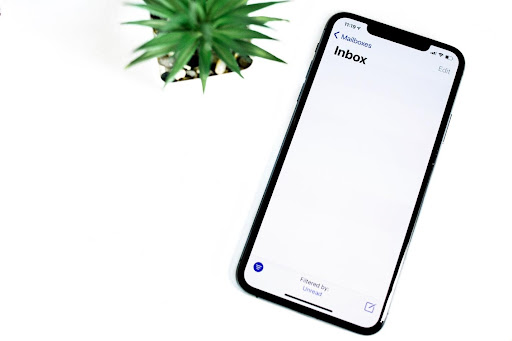
Be Personal
Mail merge has been around almost 40 years; learn to utilize it! Add your potential client’s name to the opener, and as they scan their inbox, they can’t help but do a double take. Everyone loves to see their name in print.
Keep It Simple
Overly wordy titles with too much detail can put people off; their eyes glaze over if you include jargon, serial numbers, or lengthy preambles. Think Hemingway: he famously wrote a classic short story in six words. If you find yourself being a little too wordy (or not wordy enough) consider working with a content writing service to get the creative juices flowing.
Mystery
We all like a quick puzzle. Add intrigue to someone’s day by posting a cryptic question or unusual statement as your subject line. To find the answer, they’ll have to click through to the body (and read your pitch).
Urgency
Traditional advertising recommends a strong ‘call to action,’ which can be put in the subject line, or as an alternative, you could subtly introduce a sense of ‘gentle panic’ by asking a truly compelling question.
Humor
Simple, but not easy. Hitting the right note with an informal, jokey title can sometimes be the most effective way to catch the attention of a weary exec. However, get it wrong, and you’re going to turn them off immediately. This shows the importance of our next tip.
A/B Testing
If you’re not sure which potential email subject will get the best responses, don’t leave it to chance, get hard data. Many email services will track multiple campaigns and allow you to test variations until you finally crack the nut. News organizations do this with fresh articles and will alter headlines depending reactions.
Lists
As every self-help author is aware, a list can sell almost anything (and almost anything can be made into a list!) It’s human nature to be attracted to an ordered pile of information instead of a chaotic lump of facts. You’re reading this article, aren’t you?
Friendly But Not TOO Casual
The temptation may be strong but avoid filling your subject line with flashy attention-grabbing characters. Today’s software and on-screen keyboards are stuffed with faces, cartoons, and emojis. It’s all too easy to allow our social media habits spill over into business but hold back. Stay professional and allow at most a single unusual character in your opener — this includes unnecessary exclamation marks!!!
Scarcity Adds Value
No one likes to be the only one ‘missing out’ on something. Try suggesting that your stock is running low, that there are only a few days left to act, that this is a limited-time offer, or that it’s the very last chance to avail of your service. FOMO has been a primary driver of commerce since ancient times.
Technical Questions Before You Launch
When the email arrives at the recipient’s device, will a real name show in the FROM field? Can they reply directly to your email? How much of the subject line appears as a preview? Will the email displayed properly in all clients? Would the campaign benefit from an embedded tracker? Have you chosen the correct day/time to capture your market? Will it trigger common spam filters?
Lure ’em in with $
Nothing says “I’m ready to buy” like dollar signs. People are conditioned to think that anything that costs money is desirable, and your email subject line could be the tipping point between click or nothing else.
Immediate Benefit
Never write an email subject line with nothing but a web link. Most people will hesitate before clicking through if they don’t understand what it is they’re going to get. Since a subject line has a limited number of characters, you only have a few short words to try and convey the value of your offer.
Concise & Clear
Subject lines need to be as short as possible. If you find yourself filling over 20 characters you’ve probably got too much going on and it’s time to consider another option. However, that doesn’t mean the shorter is necessarily better. Just don’t cram more than one thought into a single line. A huge part of effective copywriting is choosing the right words. It’s unlikely you’ll be able to come up with a concise, clear sentence in your first draft, so why not brainstorm phrases and test the best parts later?
___ is an excellent choice
This may not sound like much but it’s surprisingly effective in practice. It implies that the recipient is about to uncover something extremely valuable and should immediately take interest.
Try ___ for $1
Putting a price on your offer instantly gives people a reason to give you their attention. Why $1? Because it’s an amount that almost any recipient would be willing to pay for something to see if it works. If you’re offering your service for free, just drop the currency symbol and replace it with another word like ‘free’.
Prove You Know Me
If you’ve done your research before emailing someone this could be a great way of showing that you’re not just spamming them. Right out of the gate you’re showing a real connection, and it can be a powerful way to motivate them to reciprocate.
I’ve got a quick question
This is an easy way to get someone’s attention. After all, they expect most emails to be requests of some kind and it also gives you the opportunity to do so as briefly as possible. You can always come back later with another email or pick up the conversation via phone if it becomes necessary.
Enclosed is [something]
This implies that the person has already agreed to something and only needs final confirmation. If someone’s already committed to opening your email, there’s a much better chance they’ll be persuaded by your offer. It also underlines the fact that you’ve included an easy way for them to reply quickly, which can’t hurt in terms of click-through rates.
This is a quick fix
People know that complicated things are difficult to implement and understand. If you can show that what you’re offering will solve their problem immediately, then they’ll be far more likely to take note. Much like “this is a limited time offer” it implies urgency without actually having to say it.
There’s a special offer inside
This is exactly how it sounds. An immediate reason to open your email is so they can see what the deal is. It implies that the recipient will receive something extra for opening, and since many email clients automatically highlight links in bold or color, this can help you stand out from the crowd.
I’m going to ease your pain
This is a great way of coming across as understanding and empathetic. It’s a subtle way of including the reader in the email without making it feel too personal, making them more likely to respond well. The best persuaders aren’t those who try to ‘sell’ their offer, but rather those that make you feel like they’re speaking to you directly.
You’ll be glad when this is over
Another way of implying that the recipient will benefit from a certain action, and in this case, it’s opening your email in order to get the best solution. That might seem like an obvious thing to say but in practice, it can be a very effective way of guiding their decision-making process.
Nobody cares about you more than I do right now
Again, this is an easy way of showing that you’re not just spamming. Since you know exactly what’s going on it can be very effective to include this information in your email, especially if it’s something the recipient should already know about.
We need to talk
This should almost certainly be followed up with a ‘here’s what I want’ message, but it’s a great way of getting the recipient to open your email. Everyone expects an urgent message when they’re on the receiving end of this line, and that can be incredibly persuasive in some situations.
This is worth $100 ___
This is a very self-explanatory ‘call to action.’ It implies that the reader is going to get something of great value in exchange for replying, and it’s an offer that almost everyone will respond to. This should be especially effective if the thing you’re offering actually costs more than $100 — you don’t even have to say the dollar amount out loud, but you can include it in the subject line.
10 Top Email Marketing and Deliverability Tips You Should Know
According to a report, over 20 percent of emails we send never reach the inbox. Instead, they end up in the spam folder or get lost altogether. That means, every one in five emails that you send never makes it to the recipient’s inbox. All of this combined can significantly affect your email campaign performances in the long run.

Considering the number of hours you spend drafting great email copy, designing email templates, and coming up with engaging email subject lines, shouldn’t you at least ensure that all your subscribers get the opportunity to read the sent emails?
Let’s take a look at the top email marketing and deliverability tips to boost your inbox reach:
1. Build your IP credibility and reputation
Spam has existed for almost as long as email has, and it has been growing at a tremendous rate. Today, nearly 85 percent of all emails are spam. As a result, email service providers have taken stringent measures to filter emails and ensure anything that resembles spam goes straight to the spam folder.
Email service providers assess the IP of the incoming emails to determine how trustworthy they are. In case your IP seems suspicious, there is a good chance, your email won’t reach the inbox of the recipients.
That is why you need to steadily build IP credibility. If you have a new IP, start by sending out small batches of emails to people who you know are more likely to engage with the emails. After that, you can gradually increase the email volume. It’s also a good idea to monitor your IP reputation regularly.
2. Track email performance stats
Pay attention to the delivery reports you get from your email service provider to identify any potential deliverability issues with your email campaigns. While open and click rates are important from a marketing perspective, you also need to focus on bounces and complaints about optimum email deliverability.
A high bounce rate or too many complaints by recipients can easily affect your sender’s reputation. In most cases, high bounce rates can mean you are working with outdated subscriber information and you need to purge your subscriber list immediately. Too many spam complaints could also mean the recipients aren’t happy with the quality of content or the frequency of emails.
3. Allow subscribers to manage preferences
You need to make it as easy as possible for people to unsubscribe from your emails.
Yes, we know you are trying to retain your subscriber list and you wouldn’t want people to unsubscribe at all. But hear us out here — If a person just isn’t interested in your emails anymore, wouldn’t it be better for them to unsubscribe instead of marking your emails as spam which could affect your sender reputation and deliverability?
Over 43 percent of people end up marking emails as spam all because they can’t find the unsubscribe button easily. Therefore it’s necessary that you allow subscribers to manage their preferences and make unsubscribing as easy as possible.
You should include a link to unsubscribe at the bottom of all the emails you send out. It’s also a good idea to add a ‘Manage Preferences’ link in your emails which subscribers can use to change their email address and the frequency of the emails they receive.
4. Monitor domain for blacklists
IP addresses get blacklisted when they receive a large number of spam complaints in a short span of time. You don’t even have to be sending spam content to get blacklisted. If you are using an email service provider with a shared server, then your email deliverability can get affected if someone else on the shared server has been flagged as spam.
It’s way easier to avoid getting on a blacklist than it is to get out of one. If you are already on a blacklist, you should stop all your campaigns and focus on getting off of them. Sending emails from an already blacklisted domain will only make things worse.
To avoid getting blacklisted, keep your subscriber list in check, adopt good email sending habits, and consider getting a dedicated email server instead of a shared one. You should also use separate domains and IP addresses for prospecting emails.
5. Go for non-spammy subject lines
No matter how engaging your email content is, it is the subject lines that determine whether a person will open your email or not. As email service providers come up with more and more sophisticated algorithms to filter out spam, it’s important to avoid spam phrases in general that can lead your emails directly to the spam folder, or worse, get you blacklisted.
Some of the many phrases that can be marked as spam include:
- Quick money
- Eliminate debt
- Free !!!
- Limited time offer
While there is no single list that you can use as a reference, it is a good idea to write subjects that offer genuine value to your subscribers without sounding too sale-sy or pushy.
6. Personalize your emails
Adding the recipient’s name at the start of the emails can increase your open rates. You can further personalize your emails by adding accurate sender information too — which can be your brand’s name or yours. Ideally, you should add a name in the sender field to create a sense of familiarity and remind subscribers that there is a person behind the email who is trying to reach out to them. You can also add the sender name as ‘[Your Name] from [Company Name]’ to increase brand recognition.
But whichever way you choose to go, make sure to stay consistent with the sender name. Don’t flip flop and keep changing the sender name as it can make things confusing for your recipients. Consistent sender names allow recipients to instantly recognize who the emails are from which will, in turn, lower the chances of your emails getting marked as spam.
7. Review your email content before sending it through
Before you hit the ‘send’ button, make sure to review your email content thoroughly to ensure there aren’t any issues and your recipients are able to view the email properly.
Here are some tips that you should keep in mind:
- Send your email both in text and HTML format
- Preview emails on various devices
- Allow people to view your email in a web browser
- Include ALT text for all the images in your email
- Avoid using red font and large images in your emails
- Don’t use flash or Javascript in the email content
- Review all the links in your email and ensure they lead to the correct destination
8. Stick to a consistent schedule
It’s necessary to have at least some level of consistency in your campaign timings because an erratic schedule can quickly send your emails to spam. Bombarding your subscribers with too frequent emails can easily annoy them. On the other hand, sending emails too infrequently can lead to decreased brand awareness.
The idea is to create a consistent email schedule that allows you to share fresh and interesting content with your subscribers without overdoing it or going completely MIA for a long time. The right schedule will be different for everyone, which is why it’s best to experiment with different sending intervals and frequencies to find the one that works for you.
9. Clean up your subscriber list regularly
There is a definite connection between email engagement and deliverability. The more people open your emails and engage with them, the higher reputation and trust you will have. But keeping inactive and unengaged users in your email list can end up damaging your deliverability rates as well as reputation. It is not just important to know to who you should be sending emails, but it’s just as important to know to who you shouldn’t be sending emails.
Not sending emails to inactive subscribers that aren’t engaging with your emails is another way to boost email deliverability. That is why you should clean up your subscriber list regularly and create a dedicated suppression list of subscribers to who you do not wish to send any future emails.
Of course, the question here is — how long should you wait until you move someone from your subscriber list to your suppression list?
It all depends on your sending frequency. The higher your email sending frequency, the shorter the period of time for adding someone to the suppression list.
10. Conduct routine email deliverability audit
Following the best practices to improve deliverability can work to a great extent, but not when your email deliverability has already taken a hit. If you have been noticing a consistent decline in your open rate and bounce rate, even when you have been doing everything right, it may be time to conduct a deliverability audit to check for any underlying issues. In fact, it is recommended to conduct routine audits every 4-5 months to ensure you can identify issues before they cause any severe consequences.
Let MassMailer do all the work for you
MassMailer can help you conduct regular email deliverability audits and subsequently improve email campaign performance. The email deliverability audit report includes all the major factors like:
- Email infrastructure for SPF, DKIM, DMARC, and BIMI
- Domain and IP reputation
- Recipient list validation
- Inboxing placement rate
- Historical reports analysis for bounces, blocks, opens, clicks, unsubscribes, and spam reports
- Custom domain tracking
- IP warm-up
6 Tips to A/B Test your Mass Email Campaigns Like a Pro
In email marketing, one size fits all does not work. So, what worked for your competitor, may or may not work for you. The best way to find out what kind of mass email campaign works for you, is to do an A/B test. A/B testing or Split Testing is a type of experiment for your mass email campaigns that test one variable at a time and eventually optimize your emails to achieve maximum success.
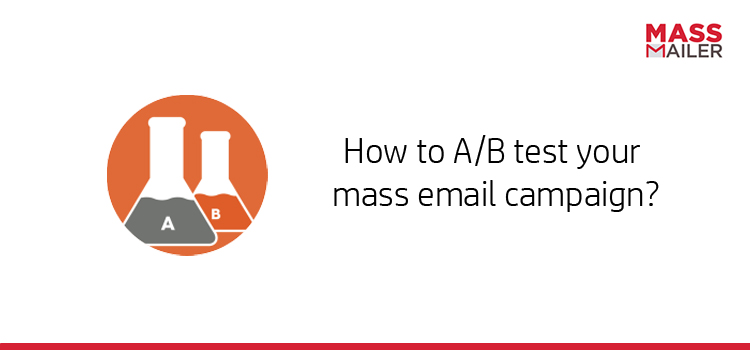
5 Time-Saving Tips for Sending Out Mass Email
Email Marketing is one of the most cost effective methods of reaching out to your subscribers. If done right, it can earn you huge dividends. However, sending out emails to thousands of subscribers can be a time consuming and tedious job. When you have hundreds of other things to look into, you may not want to spend hours on that one mass email.
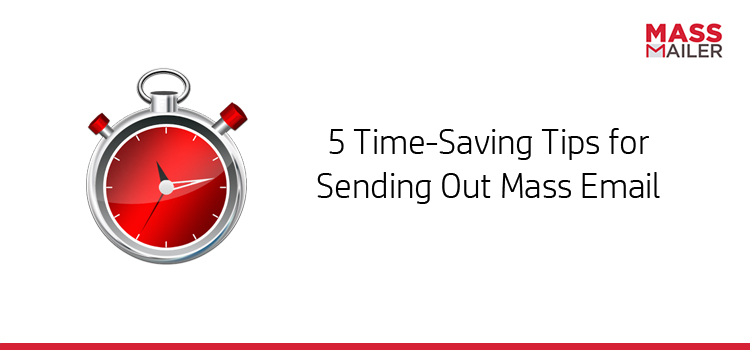
Here are 5 tips that would save you time while sending out a mass email.
- Have a clear goal
- Verify & Segment your Email list
- Use customizable email templates
- Ensure compliance with CAN-SPAM Laws
- Use an email marketing tool like MassMailer
Have a clear goal
While this may seem the most obvious tip, it is also the most overlooked one when it comes to email marketing. Before you even start building your mass email campaign, it is important to ask yourself “Why am I sending this email?”. You should have a clear idea about what you want to achieve from the campaign. Whether you are informing your customers about a new feature in your existing product or seeking to upsell or cross-sell or just wishing them well for the Holidays – whatever be the reason you are sending out the email, it should be very clear to you. This will make it easier for you to figure out the right message in your email.
Verify & Segment your Email List
Email list verification is the process of determining whether the email addresses on your list are valid and deliverable. In one of our previous articles, we discussed at length on why it is important. By removing invalid email IDs from your list, email list verification saves you time by ensuring that you do not waste time sending our email campaigns to junk IDs.
Segmenting a verified email list also goes a long way in saving you some valuable time. Let’s say your enterprise sells 2 products A and B. Having a segmented list for each of the products’ customers will ensure that you do not waste time sending out a mass email campaign for a feature update of Product A to a customer of Product B.
Maintaining a verified segmented list of email Ids will make the process of sending out mass email campaigns not only faster but also more effective.
Use Customizable Email Templates
Designing an email template from the scratch could take up a lot of your time. To make the process faster, use predesigned templates and then customize them as per your need. Most email marketing platforms today offer email templates. If you depend on Salesforce for much of your sales and marketing activity, you should choose an email tool that can generate templates from within Salesforce itself.
Ensure compliance with CAN-SPAM Laws
CAN-SPAM stands for Controlling the Assault of Non-Solicited Pornography And Marketing. It is a law that sets the rules for commercial email, establishes requirements for commercial messages, gives recipients the right to have you stop emailing them, and spells out tough penalties for violations.
Some of the dos and don’ts include:
- Don’t use false or misleading header information.
- Don’t use deceptive subject lines.
- Identify the message as an ad.
- Tell recipients where you’re located.
- Tell recipients how to opt out of receiving future email from you.
For details, you can check out The CAN-SPAM Act: A Compliance Guide for Business.
And if you are wondering, how does this save your time? Well, if you do not want to waste your time and money fighting lawsuits, this is important.
Use an email marketing tool like MassMailer
An email marketing tool like MassMailer automates the process and takes care of a lot of pain points of sending out mass mailing campaigns. Deeply integrated with Salesforce, MassMailer gives you the same refined user experience that you’re used to with Salesforce, at the same time, it lets you send emails beyond Salesforce’s limit of 5000 emails per day. It has an-built mechanism to verify email IDs, features that let you segment your list easily, professionally-designed templates that can be customized as per requirement, analytics to help you track and measure your campaign’s success and many more. MassMailer also has checks and balances in place to ensure that your email is CAN-SPAM compliant.
So go ahead and send your mass email campaign without wasting a lot of time on it. Try MassMailer today!
5 Tips to Write Killer Mass Emails that Prompt Users to Take Action
Email Marketing is one of the most effective ways of reaching out to your customers, both existing and potential. They help in communicating and building relationships with prospects, gather important data, and help boost marketing ROI.

The basic thumb rule of writing successful mass promotional emails is to Respect the Recipient. Give them the attention they deserves and do not treat them as just another name in your humongous list of subscribers.
In this post we are going to discuss 5 tips that would help you write killer emails that work.
Tip 1: Personalize
Personalize your emails with dynamic content. Personalization helps your subscriber feel that the email has been specifically written for them.
You can personalize the content of your email by inserting basic customer merge tags. Merge tags are placeholders that are replaced by actual content when the email is sent.
Hey {{user.name}}! becomes “Hey John!”
Segmenting your customers as per their interests and then sending out content which match their interests is another way of personalization.
Netflix does an excellent job in personalization. It not only adds the name of the recipient in the subject and the body of the email but also recommends programs based on the user’s preferences on the platform.
Tip 2: Follow the AIDA model
AIDA is a marketing acronym which stands for Attention, Interest, Desire & Action. The first three steps lead your audience to the fourth step of action.
Your subscriber is bombarded with hundreds of emails everyday. In order for your email to stand out and grab attention, it should have a subject line that encourages the person to open the email. Once you have got their attention, catch their interest by focusing on their needs, the same needs driven by which they clicked your email in the first place. While you are building their interest, show them how you can fulfill their desire. And last, tell them what needs to be done for them to fulfill their need.
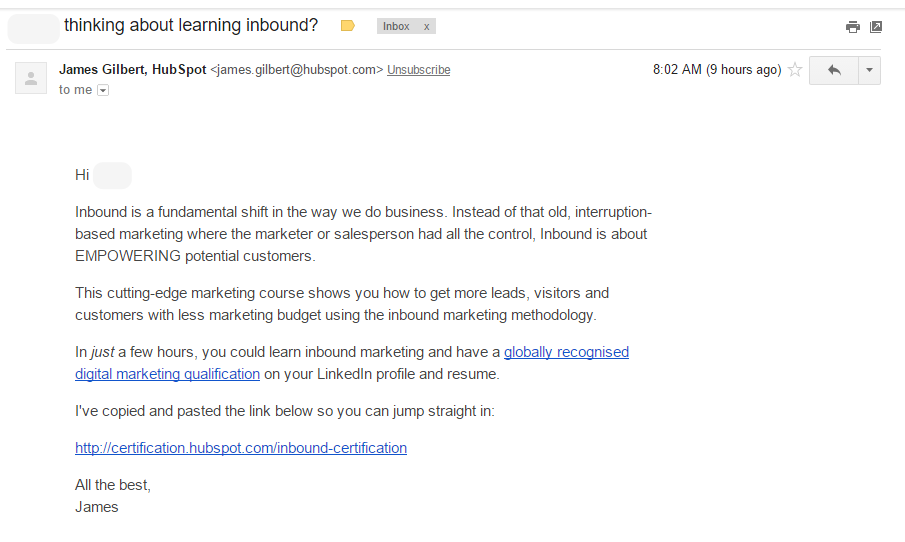
This email from Hubspot is a good example of the AIDA model. It catches attention by asking the person if they are thinking of learning about inbound. Next it builds their interest by telling them how inbound is different from traditional marketing. To create a desire for the offering, it talks about the benefits like more leads, visitors, etc. and a globally recognized qualification. And lastly, it clearly mentions the action required from them to get started.
Tip 3: Use the 1-2-3 method
When you are stuck with how to convey your message in the best possible way, use the 1-2-3 method. In this method, you define the first 3. These 3 could be the steps that you want your recipient to take or the benefits that the recipient will have. Defining the first 3 will not only simplify the messaging but will also remove any iota of uncertainty.

LinkedIn uses the 1-2-3 method to sell the benefits of Job Seeker Premium to its users.
Tip 4: Make your recipient happy
One happy subscriber is better than many unhappy ones as they are more likely to open your email again. You can make them happy in a number of ways – just say something nice or tell them an uplifting story. Giving them a little something is the easiest way to make them happy.
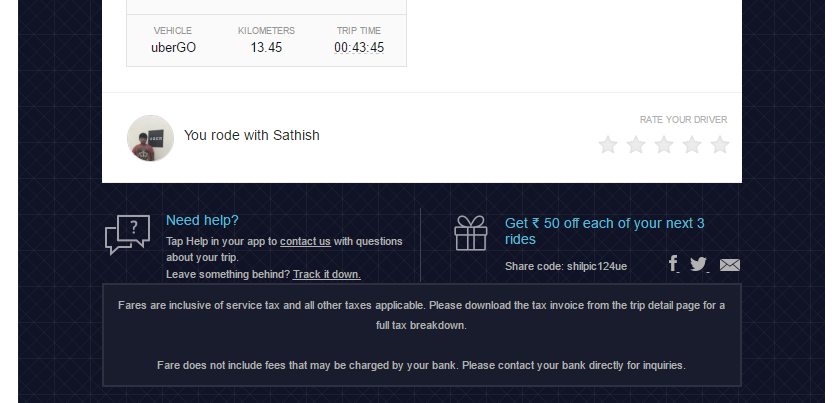
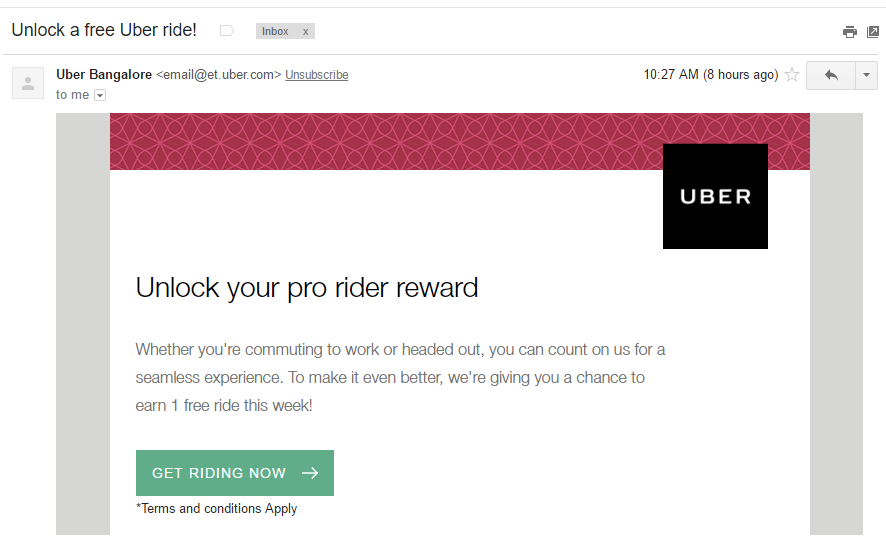
Uber provides it users a little something in a variety of ways – in the form of a referral code while sending trip receipts, providing a free ride in exchange for a certain number of rides, etc.
Tip 5: If you want the recipient to take action, make the action actionable
Simply put, if you want the recipient to click, use buttons. Make the call-to-action on the button crisp but clear. Make the button stand out from the rest of the email by using a contrasting color, adding white space around the button, adding an on-hover color, etc.
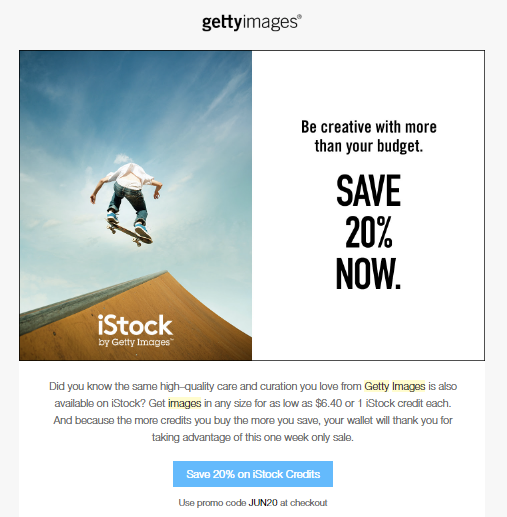
GettyImages has a clear call to action button in its promotional emails.
With this 5 simple tips, you can ace your email marketing campaign and prompt your user to take action.
Last but not the least, to ensure the success of your campaign you need an mass email tool that lets you implement all these tactics with ease. That’s exactly what MassMailer is. From merge tags, to pre-designed templates, to call-to-action buttons, MassMailer gives you all you need to capture and keep the attention of your subscribers. MassMailer is the leading mass email solution for Salesforce. To see it in action, start a free trial of MassMailer today.





